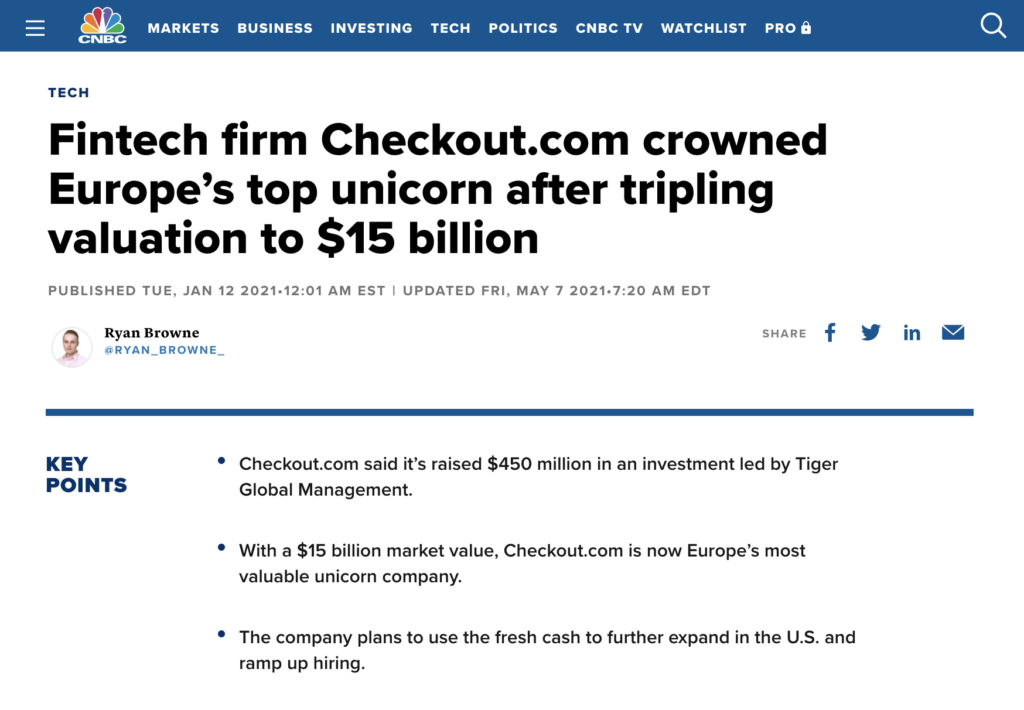Making Sense of Unicorn Startup Valuations: Is There A Bubble?
Category: Uncategorized
Companies with a billion-dollar valuation are labelled as unicorns because they were once rare creatures. But now they’re breeding more like rabbits, with over 750 reported world-wide, and more than 30 headquartered in the UK alone—which begs the question, is this growth in the population of billion-dollar companies sustainable, or is it indicative of a startup valuation bubble? And with most unicorn companies still operating at a loss, can a billion-dollar valuation really be justified in the first place?
Establishing business valuations is a complex process, with many different methods used at different times and by different industries. To begin to untangle some of this, a good place to start is by highlighting the complexities of valuations at every stage of the process.
A formal valuation for a startup company is most commonly agreed through—and because of—an equity funding round. Valuations have historically been calculated as a 7x to 10x multiple of a company’s profit, but in today’s fast-growing, venture capital-fueled tech market, reaching profitability is not usually required to secure capital injections linked to large valuations, even for relatively early-stage startups. Rather, venture capitalists place emphasis on the potential profitability of a company, and its ability to generate significant turnover, EBITDA, or other financial metrics.
Startup valuation methods
In the absence of profit, there are a number of alternatives that may be considered when valuing a company:
Times-Revenue
The Times-Revenue method determines the value of a startup by multiplying its revenue. This multiplier is usually between 5x and 10x and depends on factors such as the macroeconomic environment, business model, and track record of the management team. Whilst this is a relatively simple valuation method, it relies strongly on the assumption that revenue and profitability are linked, which is not always accurate.
Net Present Value
Net present value (NPV) is the present value of a company’s future cash flows, discounted to account for the time value of money. It is calculated by subtracting the upfront capital needed to start the company from the total value of the company’s estimated future cash flows. These future cash flows are then discounted to account for the greater value of money received in the present, rather than the future. The discount rate may be selected based on the cost of borrowing the money needed to finance the venture, the expected return of similar investments or a “risk-free” rate of return, such as the yield on government bonds.
The VC Method
Alongside these approaches, the venture capital method is commonly used for startup ventures. The estimated future exit value of the venture is divided by the return on investment that an investor is seeking. This figure is then subtracted by the total amount of capital invested in the company (post-money valuation) to give the pre-money valuation.
Of course, there are shortfalls and issues with all of these methods—it’s extremely difficult to value seed-stage, pre-revenue startups with intangible assets. In addition to this, it’s also worth noting that valuations are always framed in the context of stakeholders’ varying interests; that is to say, a company is worth more to those who want it to be worth more (e.g. the founding team who may want a lucrative exit) and less to those who want it to be worth less (e.g. a potential investor who wants a good deal).
This creates a competitive tension that is present in all valuation conversations, even in some first-round fundraisings backed by individual angel investors. Put simply, a pre-money valuation from an equity transaction is not necessarily a market price—rather, it’s the price that two parties are willing to agree on at that moment.

Difficulties in establishing a valuation
There’s no better parable to exemplify the difficulties in valuing a startup than the demise of Powa Technologies. Self-proclaimed as one of the country’s first startup unicorns and a challenger to the hegemony of Silicon Valley, Powa developed a payment processing mobile app that could scan QR codes to make a payment. Led by founder Dan Wagner, who confidently predicted that the company would eventually be bigger than Google and Alibaba, Powa reached a massive £1.6b valuation in 2014, but tumbled into administration just over a year later.
Having been hailed as the UK’s leading tech startup by David Cameron (who was also an advisor to fellow deceased unicorn Greensill), Powa’s subsequent fall from grace sparked a great deal of controversy in the media. A post-mortem investigation by administrators Deloitte suggested that the company was chronically overvalued and near insolvency at several points prior to collapse.
Just four months before the death of his unicorn company, Wagner was quoted in an interview saying “I don’t like the term ‘unicorn’. It’s creating the wrong dynamic around businesses […] Businesses shouldn’t be championed for the fact that they have an X or Y valuation. They should be championed for the fact that they have a great initiative, great products, customers and momentum—all the things that define a business as a success.” So even by Wagner’s own measures, Powa Technologies was overhyped. But the company’s collapse is not necessarily evidence of a valuation bubble in the wider market, rather evidence of how difficult it really is to value a company.
Difficulties in reporting on valuations
A number of difficulties may also arise when company valuations are reported in the media. Multiple share classes with different prices can obscure a company’s true valuation or even make it impossible to calculate, and lack of transparency in how startup valuations are calculated can restrict external scrutiny. Because of this, misguided valuations are usually only apparent in hindsight.
So how do different share prices affect a startup valuation? Companies can offer shares with different rights across different investors, employees and other stakeholders. Preferred shares can mitigate the downside costs for investors—as they are guaranteed to be paid before ordinary shareholders—so, in return, they may be willing to pay a higher price per share. If the media assume that all share prices are the same and simply multiply the price per share of the most expensive share class by the total number of shares, then the resulting figure will be inflated. The opposite problem can happen, of course, if you multiply the price per share of the cheapest share class by the total number of shares, though this would be less likely.
The lack of transparency in how reported valuations are calculated means that these cannot be easily validated by external sources. For example, a selection of the UK’s unicorns have announced their billion-dollar valuations through press releases with no indication of methodology, which cannot be confirmed because their parent companies are based in ‘secrecy jurisdictions’ that don’t have to make their share allotment forms publicly available (e.g. Farfetch, Isle of Man; Checkout.com, Isle of Man; Babylon, Jersey; OakNorth, Jersey).

Agreeing on a valuation across markets
If a company chooses to list on a stock exchange, then its valuation will have to face the music of the public markets. There are a multitude of differences in how institutional and retail investors operate, so it’s quite common for there to be discrepancies in what they’re willing to pay for shares in a particular company. The ascent of wealthy ‘megafunds’ (like China’s SoftBank) has exaggerated these discrepancies further. Investors with access to enormous pools of capital will likely be willing to pay a different (read: greater) price for shares, catapulting the valuation of its portfolio companies well above what can be supported in the public markets.
With more capital flowing through the private markets than ever before, late-stage companies are no longer needing to IPO in order to raise significant funds, and are thus staying private for longer, surviving off venture capital finance. This means they can maintain a smaller roster of investors and are under less strict corporate governance requirements than a listed company.
But delaying an exit event means that businesses are missing out on the discovery of their ‘true’ market value. Instead, they spend more time building their business upon a potentially misleading valuation, only to suffer a significant blow to expectations when they eventually do exit. Unfortunately, the former golden-child of the UK’s startup scene, Deliveroo, is one such victim. The unicorn company made its debut on the London Stock Exchange in March 2021 and lost 26% of its value in its first day of trading, earning a title of “the worst IPO in history”.
Others, meanwhile, may have had a successful stock market debut, but are struggling to maintain their sky-high values. Farfetch’s share price surged on its first day of trading, closing at $28.45, but has since dropped to a third of this. Funding Circle listed at £4.40 per share in September 2018 and is currently trading at £1.07 per share. It’s worth noting here that a drop in stock price from the initial public offering isn’t necessarily an indication of overvaluation whilst private. A listed company is vulnerable to market fluctuations, and private investors will still make a return if they can get out at a good price.
Operating at a loss: high-growth at all costs
The fact that many present-day valuations are based on the potential of a company and not its current financial position has led to much criticism and concern from the wider industry, sparking rumours of a second ‘valuation bubble’ to rival the infamous dotcom boom. At some point, high-value businesses have to prove that they have sustainable levels of growth. If investors can’t make some kind of return, then the external streams of money they depend on will eventually dry up.
So why are so many companies prioritising growth at all costs? They appear to be racing to claim a leading market position in an increasingly competitive environment. In fact, many of the UK’s highest-valued companies are direct competitors (e.g. challenger banks Revolut and Monzo, and SaaS fintechs SaltPay and Checkout.com), and need to sustain high levels of funding in order to keep up.
On top of this, large corporations are now improving their strategic responses to disruptive businesses, with internal innovation teams, corporate venturing arms, and corporate-sponsored accelerator programmes becoming increasingly common. As a result, the opportunities for high-growth companies to displace incumbents, and take advantage of their shortcomings and legacy systems, is becoming increasingly difficult. (Although those that seek collaboration in lieu of competing with more established businesses may be less vulnerable to these risks.) One advantage agile startups do still hold over incumbents, however, is the ability to park the concern for a sustainable growth rate and instead prioritise rapid expansion.
If it’s able to turn revenue into profit in the long term, then there is no foregone conclusion that a loss-making unicorn is cause for concern or a sign of a valuation bubble. It remains to be seen whether the UK’s current unicorn herd can turn their potential into cold hard cash and hefty returns for their investors…
Discover the UK's most innovative companies.
Get access to unrivalled data on all the businesses you need to know about, so you can approach the right leads, at the right time.
Book a 40 minute demo to see all the key features of the Beauhurst platform, plus the depth and breadth of data available.
An associate will work with you to build a sophisticated search, returning a dynamic list of organisations matching your ideal client.